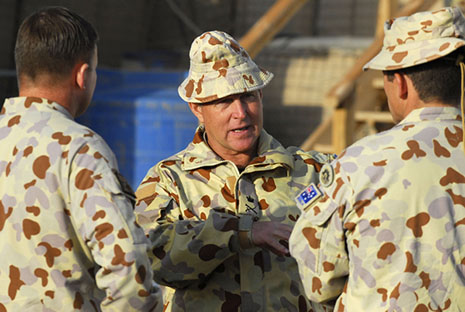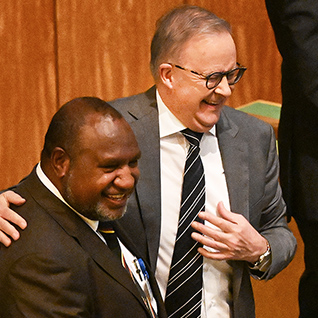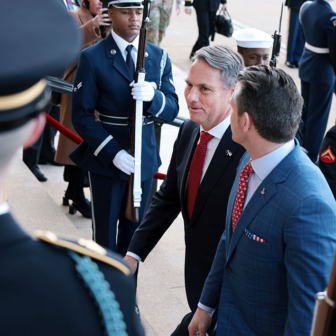LIEUTENANT GENERAL Mark Evans came out with all guns blazing last week, attacking media commentary on a leaked email sent by a soldier in Afghanistan after an Australian soldier was killed in battle on 24 August. The army’s chief of joint operations said that the commentary was “wrong and ill-informed and quite frankly not helpful,” and made specific and critical reference to “armchair generals.”
As well as breathlessly recounting General Evans’s comments, the media gave considerable space to the email from the unidentified soldier, which said the army had not supported troops adequately in the three-hour battle in which Lance Corporal Jared MacKinney was shot dead. What escaped attention was the internal army dispute that prompted General Evans’s attack on the “unhelpful” commentary. Also unexamined were General Evans’s ambiguous remarks about the contentious email’s claims. Here, for the first time, we set out the issues.
General Evans’s remarks came after retired Major General Jim Molan used the leaked email to rehearse his familiar argument that Australia needs to increase substantially the number of troops (now about 1550) it has deployed to Afghanistan. General Molan, a high-profile media commentator, also wrote in the Herald Sun that the average Australian had “a right to be confused” after General Evans’s comments.
The clash was intensified by Evans and Molan’s shared history: both are former commanding officers of the sixth battalion Royal Australian Regiment, or 6RAR. Lance Corporal MacKinney was also a member of 6RAR. These facts escaped the attention of the media but not of senior army figures, who read Evans’s remarks as a bid to discourage Molan from attacking the government’s Afghanistan policy and the army’s inability to prevail against Afghan insurgents in Uruzgan province.
As former commanding officers of 6RAR both men had a competitive stake in showing that they did a better job than their predecessors and, for that matter, their successors. Their Afghanistan contretemps reflected that rivalry. The death of Lance Corporal MacKinney was a further emotionally complicating factor.
Whatever the truth about what happened in the fog of the desperate 24 August battle, General Evans gave at best ambiguous and confusing replies to the claims in the soldier’s email. He told radio host Steve Price, “I never said the email was wrong, ill-informed and not helpful. What I said was that the commentaries were wrong, ill-informed and not helpful.” But at the same time he set out to deny the substantive claim in the email that the troops were not adequately supported by mortar, artillery and air power. “[T]here isn’t any way we would place them in harm’s way without ensuring that they have the force protection and the fire support that they need,” he said.
Perhaps it is necessary to deal first with Evans’s claim that the media commentary was not helpful. That was a silly statement. Commentary is not primarily about being helpful. Its primary purpose is to make judgements, to offer analysis, to propose alternatives. Molan might be right or he might be wrong, but as a media commentator his primary job is to question and to contest, not to help.
Judging by the transcript of his media conference, Evans was less than clear about the mortar, artillery and air support given to the Australian and Afghani forces during what was a protracted and lethal battle. He acknowledged that Australian mortars were “in support of another patrol.” Coalition (that is, US) mortars were within range in direct support of the troops but were not used, apparently for fear of hitting Apache helicopters. So the soldier was right about the lack of mortar support.
General Evans said artillery support was provided by 155 mm precision-guided munitions, but he could not confirm that only three rounds had been fired. He said the use of artillery was a decision for the tactical commander. Whether the commander’s decision was correct remains unexamined.
Not canvassed at the media conference was the uncomfortable fact that heavy artillery support for Australian troops has previously been provided by Dutch forces that have now left Afghanistan, taking their artillery with them and leaving Australian infantry without that capacity to strike Taliban forces in the field. Again, there seems to be some truth in the soldier’s claim.
Asked about the adequacy of the air support, Evans could only say, “I guess the decisions were made on the ground to utilise that fire support in a way that was appropriate to the tactical situation on the ground.” Again, those decisions on the ground remain unexamined.
There seems no doubt that the Australians acquitted themselves well in the battle. A significant but undisclosed number of Taliban fighters were killed. But the enemy force was not wiped out and the Australians do not seem to have been optimally supported with mortars, artillery and Apache helicopters. The army’s impatience with Jim Molan might be understandable, but Evans’s refusal to concede that the battle might have been other than a textbook encounter reflects the old army assumption of infallibility and an inability to cope with even mild independent scrutiny. •




